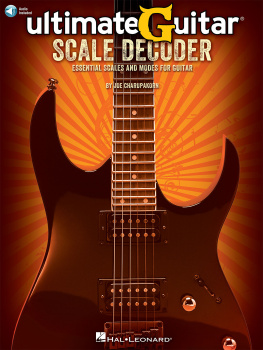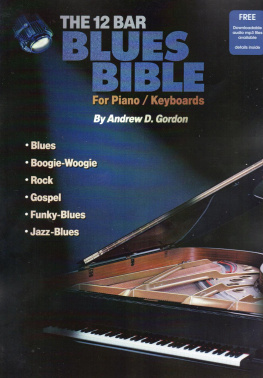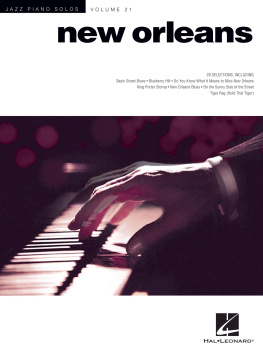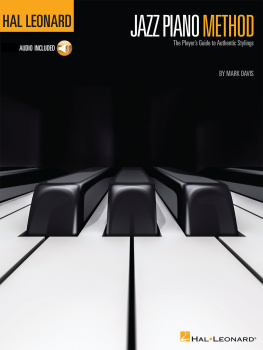The Blues Scales Eb Version
Essential Tools For Jazz Improvisation
by Dan Greenblatt
Editor and Publisher - Chuck Sher
Contributing Editors - Larry Dunlap, David Scott and Jim Rothermel
Music Copying and Editing - Chuck Gee
Cover Graphics - Attila Nagy
Cover Artwork - Kevin Neireiter
2004 Sher Music Co., P.O. Box 445, Petaluma, CA 94953 - www.shermusic.com
All Rights Reserved. International Copyright Secured. Made in the U.S.A.
No part of this book or audio CD may be reproduced in any form
without written permission from the publisher.
ISBN 1-883217-40-7
NOTES TO USERS OF THIS DIGITAL BOOK
1) Unauthorized duplication, uploading, file-sharing, freedownloading,
copying or distribution of any kind of this digital book constitutes theftof
our intellectual property and is expressly prohibited without written
permission fromthe publisher.
2) The audio portion of this book is available for free download at http://www.shermusic.com/new/downloads.shtml. See the left-hand sidebar of our homepage.
Endorsements
An excellent addition to the growing number of books and CDs dedicated to mastering the art of jazz improvisation. Useful to beginners as well as advanced players, The Blues Scales admirably addresses the vocabulary of the blues, the root of jazz.
Michael Brecker - saxophonist
To actually play the blues, you have to know whats in the blues. Dan has done a marvelous job of dissecting the blues and then bringing all the pieces back together so you can make beautiful music. This book will help those who want to have fun playing the blues.
Jamey Aebersold - one of the worlds foremost jazz educators
Dan has done a great job with this book! A good method for teaching blues and jazz improvising to beginning students has been much needed. It has been a long time coming, but finally that need has been filled.
Junior Mance - pianist with Dizzy Gillespie, Cannonball Adderley, Lester Young, Dinah Washington, etc.
Finally a conscientious educator has created a method which focuses on blues scales. Its sure to enhance the aspiring improvisors vocabulary, as well as expand their ideas for composing. Dan Greenblatts style of conveying this information is crystal clear, and this will help the aspiring student to become a far more impressive improvisor. Dont miss this book if you wish to strengthen your musical articulation.
Reggie Workman - bassist with John Coltrane, Art Blakey, Elvin Jones, Wayne Shorter, Max Roach, etc.
I have seen first-hand how well Dans systematic and insightful approach to teaching jazz improvisation works with students. With the publication of this book, jazz educators finally have a clearly presented method for teaching improvisation, with the goal of helping students develop the necessary vocabulary to create intelligent, authentic and inspired jazz solos that actually deal with the changes! The Blues Scales will become my essential tool for teaching improvisation at Roosevelt High School.
Scott Brown - Director of Bands, Roosevelt High School, Seattle, WA and Faculty Member, Jazz at Lincoln Centers Band Director Academy
This is a valuable book, with an innovative and well-explained approach to using Blues Scales in jazz improvisation.
Bill Kirchner - jazz educator and editor of The Oxford Companion to Jazz
Notes on the Accompanying CD
On the inside back cover of the book you will find the accompanying CD that shows you how each exercise should sound and also gives you a world-class play-along CD to practice with. There are two kinds of tracks on the CD:
1) On some tracks, the author plays the written exercise and then leaves you with the rhythm section to continue practicing the idea presented on your own.
2) On other tracks, Dan plays the written material and then gives you a demonstration, along with the rhythm section, of how a sample solo on the idea presented might sound. After you have listened to these tracks with the saxophone (left channel) on, feel free to turn the saxophone off and use the rhythm section accompaniment to practice along with.
Acknowledgments
Wed like to thank all the people who were essential to the realization of this project: to Larry Dunlap, Jim Rothermel and David Scott for contributing some cool blues vocabulary; to Michael Zisman and Jim Nadel for help with the text; to Chuck Gee for numerous helpful suggestions and another world-class music copying job;to David Marck, Ed Fuqua and Chris Roselli for their way deep in the pocket playing on the accompanying CD;to Peter Karl Studios, Brooklyn, NY for the excellent recording of the CD and Gary Mankin of San Francisco for the masterful mixing and mastering work; to Chuck Stewart, Bill King and Paul Hoeffler for the classic photographs; to Attila Nagy for the cover and text graphics; to Kevin Neireiter (www.jazzlandscapes.com) for the beautiful cover artwork of McCoy Tyner; to all the great jazz musicians past and present who inspire us to learn and grow in the music; and to our families, who made it all possible.
Dan Greenblatt & Chuck Sher
About The Author
Saxophonist and educator Dan Greenblatt spent 24 years on the jazz scene in Seattle, where he was best known for his performances and recordings with bassist/composer Chuck Metcalf and with the Seattle Repertory Jazz Orchestra. In these groups he worked with all of Seattles top jazz musicians, such as Jay Thomas, Marc Seales, Randy Halberstadt, and Don Lanphere, as well as many national artists including Quincy Jones, ClarkTerry, Ernestine Anderson, George Cables, Arturo Sandoval, Jimmy Heath, and Frank Wess. As an educator, Dan was the saxophone and improvisation coach for ten years for Seattles award-winning and nationally recognized jazz programs at Washington Middle School, Garfield High School and Roosevelt High School.
Greenblatt moved to New York in 2002 to teach at LaGuardia High School for the Performing Arts. He joined the faculty of the Jazz & Contemporary Music Program at New School University in 2003, and became the programs Director of Academic Affairs in 2004.
INTRODUCTION Starting With The Blues Scales
BEGINNERS
Even if all you know is the basics of how to play your chosen instrument (how to read the notes on the staff, the major and minor scales, some chord arpeggios, how to count beats in a measure, etc.), you are ready to use this book to begin learning how to play jazz.
In this book we will show you how to create meaningful jazz solos, even if your technical proficiency and knowledge of music theory are limited, using the Blues Scales (yes, there are more than one!). You will learn to acquire and employ a blues vocabulary so that your playing will start to sound like real music quickly, rather than at some distant point in the future.
Besides its practical value, we chose this approach because it mirrors the development of jazz itself, which was rooted in the blues and basic tonal centersrather than elaborate chord changesuntil the advent of bebop in the 1940s. Well be looking at examples of phrases by swing masters Lester Young, Sweets Edison, and Johnny Hodges; boppers including Charlie Parker and Dizzy Gillespie; modern improvisers and composers including Dexter Gordon, Horace Silver, Cannonball Adderley, and Miles Davis;funk and fusion players such as Michael Brecker, David Sanborn, and Jaco Pastorius; and many others. From these great artists you will learn how to use this most basic vocabulary of the jazz language.











